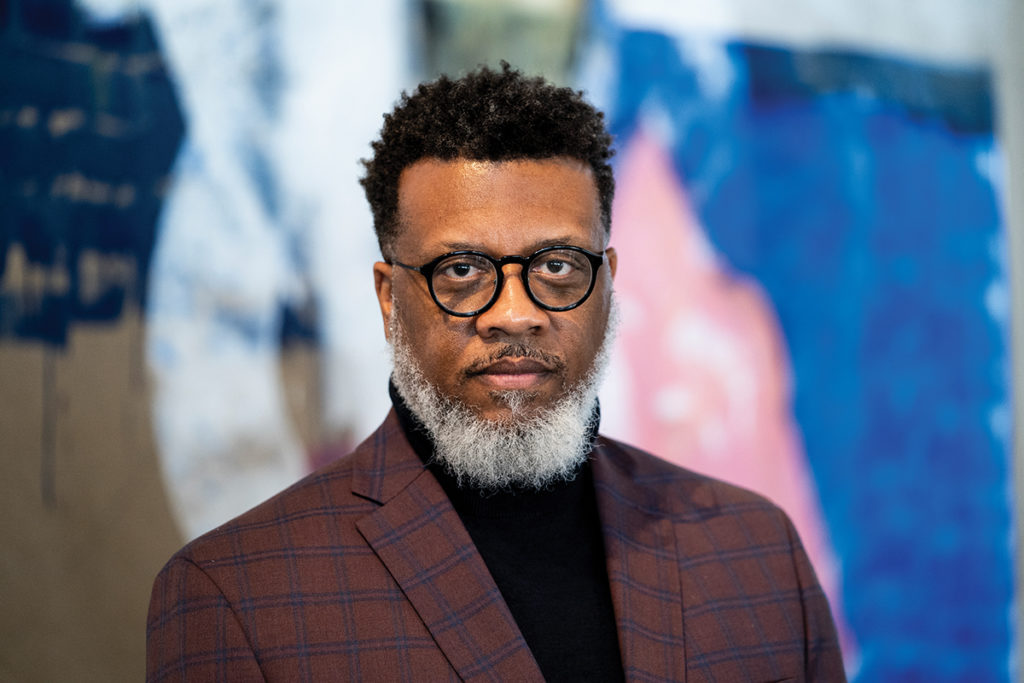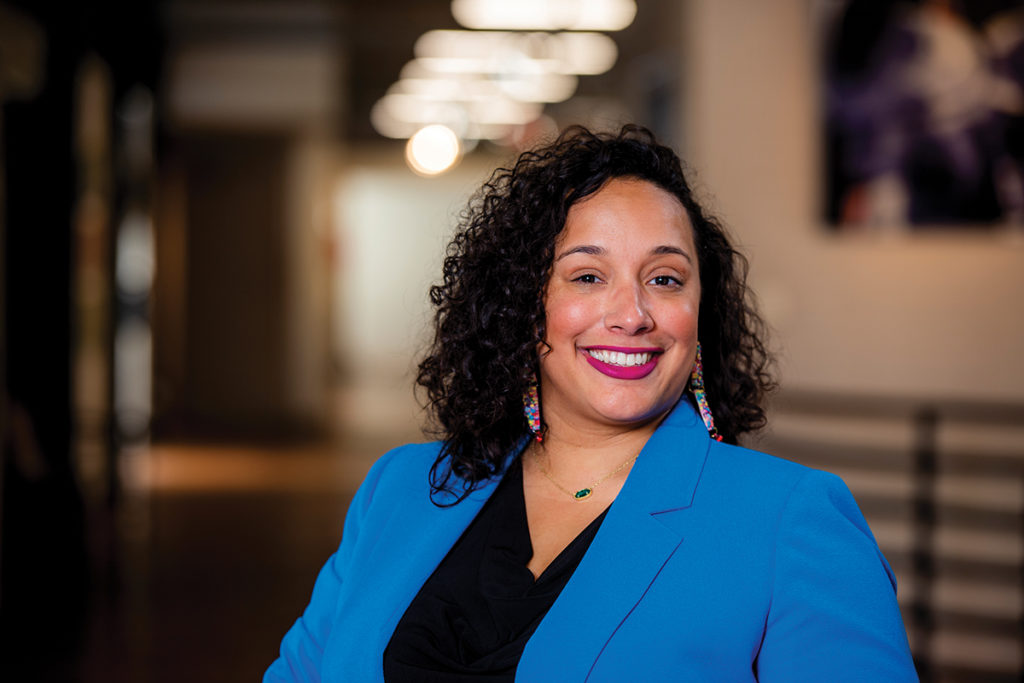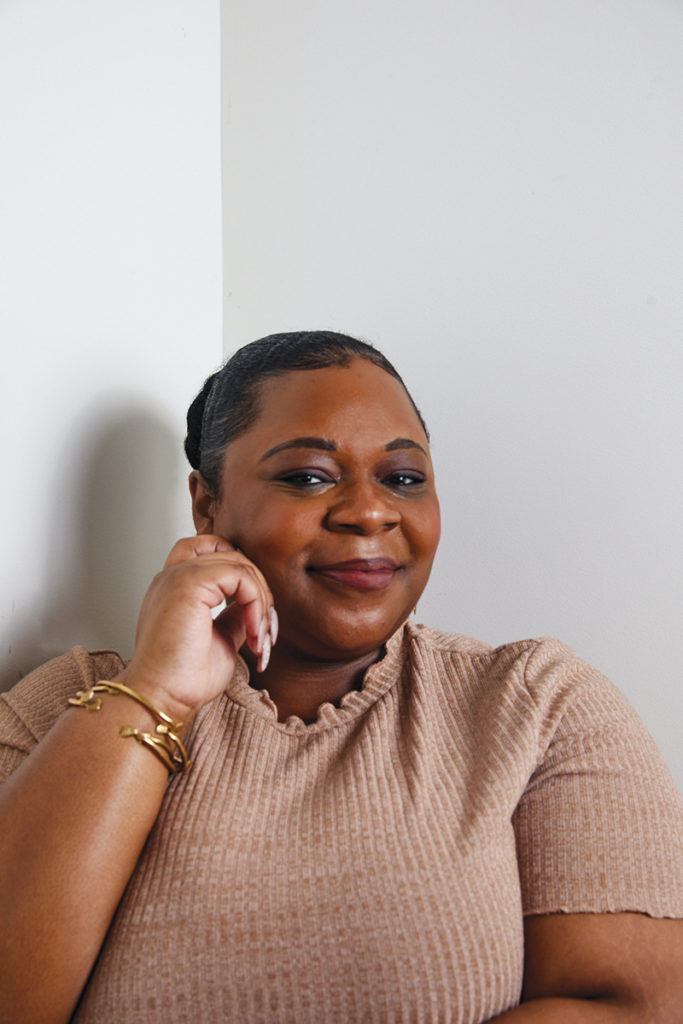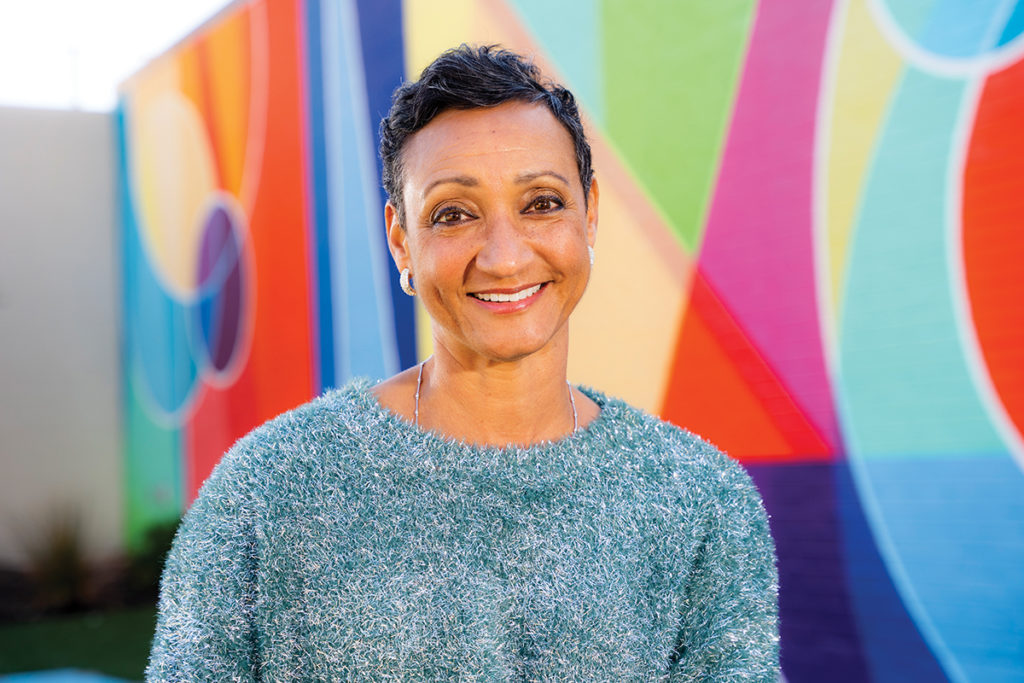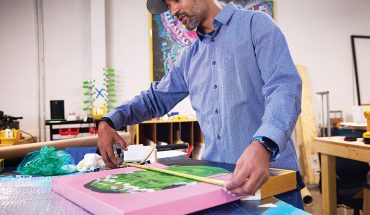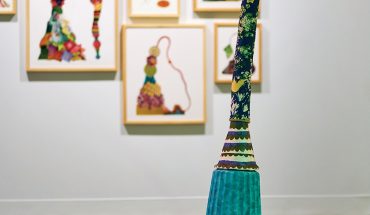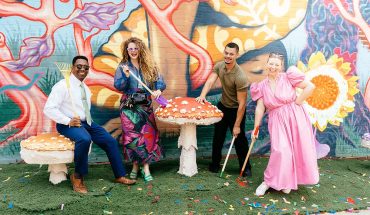Over the last year and a half, CAM, Artspace, VAE and Artsplosure have each hired new directors. Here’s what they want to do.
by Hampton Williams Hofer | photography by Bryan Regan
As of the past year and a half, four major downtown arts organizations have new faces at their helms, eager leaders who are breathing new life into the city’s dynamic art community. Each has inherited a storied art institution with long traditions in Raleigh, and each joins at a time of rebuilding.
Recent years have brought upheaval and reckoning, particularly downtown, so the new directors — who bring fresh talent to the city’s art stage — aim not only for growth but inclusion.
Artspace CEO Carly Jones is one of these new leaders. The Raleigh native joined the nonprofit visual arts center on E. Davie Street in 2021 after a nationwide, paid search for the position. For this longtime community advocate and arts enthusiast, Artspace was in her bones: She had been a kid at its art camp and a young adult at its First Fridays. Now she is in charge. “I consider nonprofit leadership to be a public service,” says Jones, “and I am honored to give back to the city that raised me in this creative and special way.”
Artspace is all about removing barriers to make art, including the creative process, accessible to all. Since its inception in 1986, Artspace has engaged with over 2 million visitors. A creative space for arts education and social practice, Artspace hosts artist exhibitions in three galleries and has over 25 studios where artists work with various materials and techniques, from painting to printmaking.
Jones joined as the post-pandemic world slowly returned to life, and from the beginning, she was opening doors and making sure new people found their way to Artspace.
During the recent FRESH exhibition, which included more than 250 North Carolina artists, many participants celebrated having their first piece featured in a gallery show.
“It has warmed my heart to experience exhibitions that are a celebration of our artists’ communities and their many cultures, integrating music, dance, poetry and food that complement the visual art,” says Jones.
The Summer Celebration exhibition of youth art gathered families across the Triangle to celebrate their children’s artwork: “It has been a thrill to see the pride of new artists and their families as they enter the doors of Artspace to a place that is fully welcoming,” says Jones.
“Our amazing team works hard to make sure we have opportunities that are inclusive and celebratory of all people throughout the Triangle.”
Previously, Jones had worked with the North Carolina Arts Council to provide support for arts organizations across the state, so she already knew that Artspace was a hub for the largest public community of visual artists under one roof in the state. Along with exhibition spaces and classes for any ability, Artspace provides subsidized studio space for all artists.
“My hope for Artspace is to change and grow with our city, as more people from diverse backgrounds call Raleigh home,” says Jones.
Three blocks away, nonprofit gallery and creativity incubator VAE (Visual Arts Exchange) lured new director Kayla Coleman down from New York City to its new office on Fayetteville Street in January 2022. Former VAE Director Brandon Cordrey said it was clear from the committee’s very first conversation with Coleman that she was the leader for the job.
“Kayla has the skills, knowledge and personality to build a coalition,” he says, “and to use VAE to meet the current cultural moment and shape our community’s artistic future.”
A lifelong New Yorker, Coleman had been the deputy director of the Percent for Art Program, which commissioned and curated public art for the NYC school system, the largest in the country. Coleman saw the VAE job as the culmination of her passions for art and access, a chance to work with a vibrant community of artists in a way that she had not been able to before. “I can work closer with artists in Raleigh, because I am no longer an employee of a city,” she says.
“I can work from passion to affect change without the pesky interference of government oversight, which allows me to give resources and opportunities directly to those who need them, without waiting on the slow wheels of policy to turn.”
Here, she says, she can learn artists’ needs and create opportunities with rather than for them. “Sometimes, it’s as formal as using a steering committee, and other times it is just having a conversation,” says Coleman. “When you work with artists and creatives, you tend to wear a lot of hats. There’s a vein of DIY in all of us, because we are able to do so much with limited resources.”
VAE organizes more than 80 exhibitions and community programs each year and provides some $200,000 in funding for artists. Coleman’s biggest goal is to expand the scope of their reach. “More than anything,” she says, “I want people to see VAE as a resource. I want the equitable opportunities to continue to flow — whether it is through innovative programming, fellowships, granting opportunities, internships or more, I want to be able to provide across the spectrum.”
For one, she wants to further develop their Collaborative Curatorial Fellowship, which supports a fellow to research an idea and turn it into an exhibition. “I encourage people to tell me what they need. If I can figure out a way to make it happen,” she says, “I will.”
A few blocks further west, Dr. Paul Baker joined the Contemporary Art Museum of Raleigh (CAM) team as executive director in August. He got his start in museums giving gallery talks as an undergraduate art major at the University of North Carolina at Chapel Hill. With a masters in Public History, as well as a Ph.D. in Leadership Studies and Policy from North Carolina A&T State University, Baker completed his certification in museum management at Harvard University. The research lover has also completed fellowships at Yale University, the University of Virginia and the University of Oxford.
Having lived in Raleigh for more than 20 years, Baker came to CAM from North Carolina Agricultural and Technical State University, where he served as director of the university galleries and a tenured professor of history. At CAM, he aims to continue the museum’s upward trajectory as an approachable museum. “We want to continuously bring new people through the doors through engaging exhibitions and programs,” he says. “We want to launch emerging artists’ careers, give them the opportunity to shine and share their talents.”
One of Baker’s particular passions is fostering an affinity for visual arts in young people. A new project called Art in Educational Spaces places art from CAM’s collection in local libraries, middle schools and elementary schools. It’s all about exposure, he says: “Who knows what future artists will be inspired from a project like this?”
The newest of the new faces of downtown art is Jaci Field, who started as executive director of Artsplosure, a nonprofit arts and cultural event production studio, in early October. The Cary native brings 29 years of event management experience to the job, having worked the Olympic Games in Atlanta, and, most recently, as the assistant athletic director of capital projects and facilities at UNC-Chapel Hill, her alma mater. “Raleigh won my heart when I moved here almost 19 years ago,” Field says. “I love the neighborhood feel with the big city offerings. I love how vibrant Raleigh is.”
Artsplosure enriches the community through experiencing art, and it’s best known for WRAL First Night Raleigh, the New Year’s celebration that’s become part of the fabric of the city, and for its annual art festival Artsplosure. For two days each May, the festival takes over downtown, lining Fayetteville Street with imaginative installations, a huge art market, interactive crafts and live music.
“Artsplosure brings art to the community in a way that creates a feeling, a vibe and memories,” says Field. “Looking back at photos of the Paperhand Puppets, the gratitude art wall or the Bubbles installation in City Plaza, Artsplosure reflects the vibrancy of who we all are here in Raleigh.”
Artsplosure is funded in part by the City of Raleigh and the North Carolina Arts Council. “I appreciate that local government is managing the continual growth in thoughtful and relevant ways,” says Field. “Artsplosure’s events reflect that growth and change.” Like Baker, Field aims to ensure her organization is poised to grow along with Raleigh’s diverse community. Artsplosure is, she says, the perfect blend of production, tradition and growth. “One thing that differentiates Artsplosure is the high caliber of art without the barrier of entry,” says Field. “I want to utilize my event experience, love for the arts, passion for making art accessible and my joy for helping others to continue this great tradition.”
An exhibition coming in March to CAM is an example of the important work these organizations are doing to nurture local talent. Textile artist Aliyah Bonnette uses improvisational quilting to stitch together stories of Black women across time.
Her work has been shown through VAE, she was also a former Artspace summer art camp intern, and she is this year’s regional emerging artist in residence at Artspace. “Bonnette is so interesting as an artist,” Baker says, “because her talent is inspired by generations of women in her family who sewed and quilted.”
For Bonnette, these organizations have been welcoming and validating. “Being at Artspace helped me get comfortable with having a public studio space, and has been a great opportunity to meet people from all different walks of life and facilitate conversation centered around my work,” Bonnette says. “The Raleigh art community welcomed me and my work with open arms.” Baker sees the value in community-driven artists like Bonnette. “As Raleigh grows,” Baker says, “CAM will grow along.”
If a city’s art community is indicative of its vibrancy, of its connectedness, then Raleigh is flourishing. “I’m proud of my home, and I understand why folks want to plant roots here,” says Jones. “Our people, our food, our culture and our arts scene are all a part of the tapestry that makes Raleigh so special.”
This article originally appeared in the January 2023 issue of WALTER magazine.

